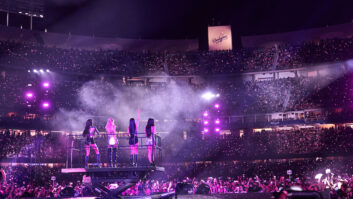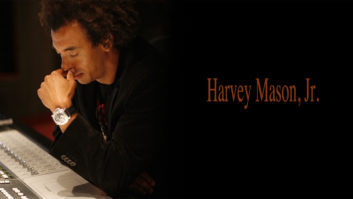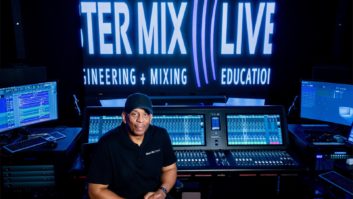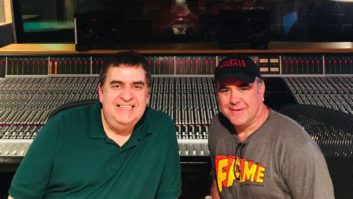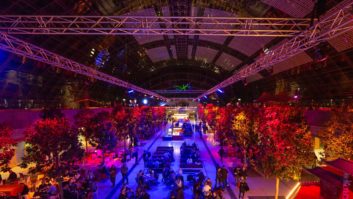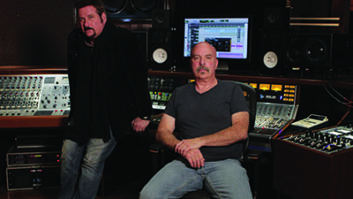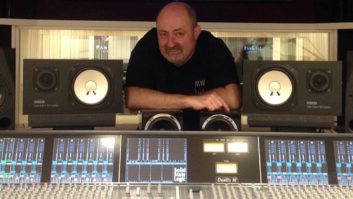As this issue of Mix hits the street, Destiny’s Child has finished a touring year that has seen the popular R&B trio go from being an opening act singing entirely to prerecorded tracks, to headliners with a full band playing in large sheds and arenas. They’ve crisscrossed the United States topping MTV’s TRL Tour (which also featured 3LW, Dream, Eve and Nelly rapping and singing to tracks) and have developed a huge following around the world. No doubt about it, Destiny’s Child is a worldwide phenomenon at this point, with sales of their latest CD, Survivor, approaching the five million mark worldwide, and still spawning one hit single after another: “Independent Women Part 1,” “Survivor,” “Happy Face” and “Bootylicious.”
These hard-working young women deserve their success, too. They are excellent singers; their material is an appealing blend of contemporary pop and R&B styles with gospel and traditional soul flavors mixed in; they put on a visually exciting, very well-paced show with just enough pyrotechnics and costume changes to keep their mostly teenaged, female audience enthralled every second; and they are, reportedly, excellent role models for their fans — their lives and their lyrics are both clean. When I saw them perform this summer at the Chronicle Pavilion in Concord, Calif., they kept the sold-out, racially mixed audience blissfully on its feet for nearly all of their 70-minute set, and everyone seemed to know the words to every song and happily sang along. It was, in short, a triumph.
Sonically, it was an outstanding show, as well, with loud but crystal-clear sound filling the covered shed and the surrounding lawn seats. Con-cord can be a somewhat difficult venue soundwise, but this time around, FOH engineer Ramon Morales won the battle. “I was a little worried going into Concord,” he says, “because when we were there last year [Destiny’s Child opened for Christina Aguilera there in 2000], I didn’t think it sounded that good, so I was afraid maybe I was going to have a tough night. But this year, it sounded fine; I liked it.”
Morales, who is based in the group’s hometown of Houston, has been working with Destiny’s Child for more than two years, and besides doing their FOH sound, he also did some engineering on Survivor and on about half the songs on their upcoming CD of Christmas songs. He credits the tour’s Clair Brothers sound system — dominated by hanging stacks of the company’s proprietary I-4 speakers, 14 on each side and six S-4 subs on the ground per side — for the presence and clarity of the overall sound. “I’d used [the I-4 system] before, but it was never a situation where it was there for me; we were the opening act. On this tour, the first day I walked into rehearsals and heard it, I thought ‘Wow!’ I was afraid that maybe I was going to have to work it a lot to make it sound good in all these different places, but it did really well; all I had to do was a couple of things here and there with the frequencies in each room, but that was it. It was always ready to go and sounded clean. Ever since I’ve used the I-4s on this tour, I don’t want to use anything else. I’m really happy with them.”
Though Morales says he’s “itching to try” the Clair/Showco Showconsole, on this outing he used his favorite Midas board, an XL-4, and an XL-3 sidecar (which was used mostly for the opening acts, each of which had its own engineer). “I love the EQs on the XL-4,” Morales says. “I’ve used so many different consoles, and on some you have to kill the EQ to hear anything, but the XL-4 is so transparent, and it’s got a warm sound to it. To me, it’s a great console.”
Morales says that because the three singers — leader Beyonce Knowles, cofounder Kelly Rowland and newest member Michelle Williams — are so strong, he doesn’t like to add too much to their vocals, which are sung through Shure SM87 mics. “On most songs, I’ll use some compression and maybe a little reverb, but I try to keep it simple and let their voices stay out front, because everybody wants to hear them sing! They’re such good singers; they amaze me.” Morales’ principal reverb is a Lexi-con 480, and he uses Manley Variable-Mu compressors on the vocals.
The TRL Tour is the first Destiny’s Child tour to feature a backing band, and a good one it is, with the very talented lead guitarist Rob Bacon acting as musical director for a unit that also includes drums, bass and two keyboards. Like many of the younger pop and R&B acts, Destiny’s Child also augments their sound with some prerecorded tracks.
“The objective, according to Matthew Knowles, who is Beyonce’s father and their manager, was to retain a lot of elements from the record and still have the aesthetics and feel of a real band,” comments Allan Starks (known to one and all as “Sparky”), the programmer who was assigned the task of collecting those extra prerecorded tracks and then inserting them into the show. The first part of that proposition was a little harder than anyone had anticipated: “What we decided to do was go back in and get all the elements from the record so they could actually have them at will, if they needed them,” explains Sparky. That entailed sorting through dozens, even hundreds, of Pro Tools sessions, some of them on unlabeled CD-ROMS, in search of appropriate vocals, instrumental and effects elements to flesh out the sound and provide familiar elements from the albums.
“What I did was come up with 24 categories that everything would fall into, and then I worked from there,” says Sparky. He first loaded all the tracks into a Roland VS-2480 24-track, 24-bit/96kHz digital workstation, submixed them further, and then took his rig on the road and operated it from the offstage-right position. Eye and in-ear contact with musical director Rob Bacon was critical for anticipating cues and any potential problems. “I feel it is very important to be able to ‘read’ the musical director and the artist, and be able to compensate for anything that might not feel right to them, and be able to fix it before they try to communicate it to me,” notes Sparky. He already had extensive experience in this area, having used the earlier Roland VS-1680 on tours with Tyrese, Kenny Loggins, Mary J. Blige, Toni Braxton and others.
In this case, “I had a kick and snare and then each of the girls’ channels; I came up with six channels of background vocals — three pairs. One pair would be the main background hook, another would be a softer, whisper-type background and the other would be verse harmony. I had each of those on a pair of faders, so if they needed more at the FOH, I could do it from those faders.” He and Morales communicated through Clearcom headsets.
Sparky continues, “I sent a click to the drummer and seven other channels to the house: a pair of vocals, because I had the other six vocals on my own, a stereo mix of what I call the metal mix — hi-hats, tambourines and things like that — an effects channel, a single 808 kick and strings.” Sparky used four 2480s over the course of each show, two for each half of the concert. One would play the tracks for one song, another the tracks for the next one, and it would go back and forth that way. All four were routed through a Roland VM-7200 digital mixer.
“The reason I picked this whole rig,” Sparky says, “was, not only would it run the show efficiently, but when Destiny’s Child does spot dates or tracks dates, they can take one of those boxes and do the show without the band. Also, they’re great for recording. Beyonce’s getting quite a bit into writing, so I’m showing her how to work it so she can take a box with her and arrange her vocals.
“When they go into the studio now, I’ve got everyone backing everything up in the proper format so I can dump it into the box and we’ve got it ready, so I don’t have to go through the nightmare I went through at the beginning of the tour.”
Both Sparky and Morales say that as the tour went on and the band got stronger, they relied a little less on some of the prerecorded elements. “I don’t think it takes away from the show at all to have the tracks,” Sparky says. “Actually, they put a nice blanket on the sound.” The keyboard setup was also quite substantial and added much to the group’s sound; tech Terry Fox worked with 16 channels of keys going through a pair of Mackie mixers.
Monitor duties for the tour fell to Pittsburgh-based engineer Doug Deems, who has extensive experience over the past decade-plus, working with such diverse clients as David Sanborn, Julio Iglesias and Kid Rock (with whom he was working right before Destiny’s Child). Like Morales, Deems likes to use Midas consoles whenever he can; for this tour, he had a pair of Heritage 3000s, “using all 34 outputs on the first console and 10 or 12 on the second one,” he says. “There was also a lot of communication going. Me and the house guy [Morales] and the sampler guy [Sparks] and the music director [Bacon] had live mics that went into our own ears.”
The entire band used in-ear systems — the brand-new Future Sonics EM3 models, which worked flawlessly and were supplemented with Clair subs for only the drums and the keyboard positions. The singers, however, used a combination of Clair 12AM and 12AMII wedges and HL-15 sidefills; both are necessary because the singers move around a lot. “I’d like to get the girls on ears,” Deems says. “And I’m sure eventually we will. But they had an experience a while ago where they were going to try [in-ears] on this television show, and they ended up getting only about a five-minute soundcheck, and then they went on live TV having never used ears before, and it didn’t work out too well, so they’ve been a little hesitant ever since. On this tour, between having a new band and a big set and dancers, I didn’t want to come in and say, ‘By the way, we’re also going to change the way you’ve heard everything in your life onstage — here, stick these in your ears.’ That might have been a little too much right off the bat.”
Deems says that early in the tour, the wedges and sidefills were dominated by the women’s vocals and some rhythm tracks — after all, they were used to singing to tracks — but now that the band has gotten so strong and become such an important element in the sound of the show, the singers decided that they need to be able to hear more of the live musicians in their onstage mix. In his mix of the three of them, Deems will occasionally use some PCM 70 reverb on lead vocals and H3000 to thicken backgrounds, but mostly he keeps the sound clean and simple, and so far that has been enough — it’s a testament to the singers’ level of comfort with their onstage sound that they rarely come to soundcheck anymore. “They’ve been really easy to work with,” Deems comments.
“They’re so nice,” adds Ramon Morales,“some of the nicest people I’ve ever met. I’ve worked with them a long time and they’re just really nice girls. They’re very family-oriented, they don’t have the star mind at all; none of that stuff. They’re nice to each other. They care about their audience. And they work hard. They just want to make it better.”
Destiny’s Child will be headlining a U.S. arena tour this winter.
Blair Jackson is senior editor of Mix.
